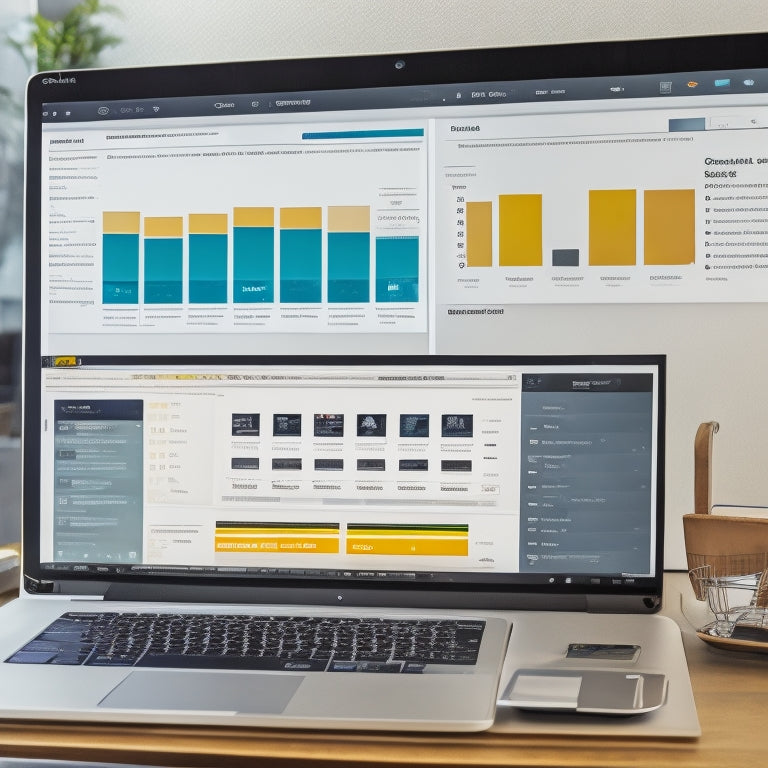
7 Best Digital Literacy Benchmarks for Ecommerce Merchants
Share
You need to master seven digital literacy benchmarks to stay competitive in ecommerce. First, you should have foundational web development skills, including responsive design and SEO basics. Next, you need to be able to analyze and interpret data to inform business decisions. Proficiency in your ecommerce platform, digital marketing fundamentals, and customer experience optimization are also pivotal. Cybersecurity best practices are essential to protect your business, and omnichannel sales strategies can help you reach more customers. By focusing on these areas, you'll be well on your way to driving sales and growth - and there's more to explore to take your ecommerce business to the next level.
Key Takeaways
• Ecommerce merchants should prioritize foundational web development skills, including responsive design, SEO, and performance optimization.
• Proficiency in data analysis and interpretation is crucial for informed business decisions and data-driven marketing strategies.
• Mastery of ecommerce platform navigation, product catalog management, and order processing efficiency is essential for smooth operations.
• Digital marketing fundamentals, such as social media leverage, SEO optimization, and paid advertising, drive brand awareness and customer engagement.
• Implementing cybersecurity best practices and prioritizing customer experience optimization are critical for building trust and loyalty with customers.
Foundational Web Development Skills
You need a solid grasp of foundational web development skills to create and maintain an ecommerce website that attracts and engages customers. This foundation is vital, as it directly impacts user experience and ultimately, your bottom line.
You must be proficient in responsive design techniques to guarantee your site adapts seamlessly to various devices and screen sizes. Browser compatibility is also necessary, as you can't afford to alienate users due to technical issues.
Additionally, you should have a solid understanding of SEO basics, such as optimizing page titles, meta descriptions, and header tags. This will enhance your website's visibility in search engine results, driving more organic traffic to your site.
Besides, you need to prioritize website performance, ensuring fast loading speeds and minimal downtime. A slow website can lead to high bounce rates and lost sales.
Data Analysis and Interpretation
With a solid ecommerce site in place, it's time to turn your attention to data analysis and interpretation, where you'll uncover insights that can inform business decisions, optimize marketing strategies, and drive revenue growth.
You'll need to master data visualization techniques to present complex data in a clear, actionable way. This involves choosing the right data interpretation methods to extract meaningful insights from your data.
To do this, you'll need to be proficient in statistical analysis tools like Google Analytics, Excel, or Tableau. These tools will help you identify trends, patterns, and correlations in your data.
Once you've extracted insights, you'll need to present them in a way that's easy for stakeholders to understand. This is where data presentation strategies come in. You'll need to craft compelling narratives around your data, using visualizations and clear language to drive your point home.
Ecommerce Platform Proficiency
As an ecommerce merchant, you know that mastering your platform is vital to running a successful online store. You should be able to navigate your platform with ease, effortlessly managing your product catalog and processing orders efficiently.
In this section, we'll explore the key aspects of ecommerce platform proficiency, including platform navigation mastery, product catalog management, and order processing efficiency.
Platform Navigation Mastery
Mastering your ecommerce platform's navigation is essential to efficiently managing your online store, from creating and editing product listings to fulfilling orders and tracking inventory. You need to be able to find what you need quickly and easily, without getting bogged down in menus and submenus.
To achieve platform navigation mastery, you should focus on the following key areas:
| Area | Mastery Criteria |
|---|---|
| Dashboard | You can customize your dashboard to show key metrics and frequently used features. |
| Product Management | You can quickly locate and edit product information, including images and descriptions. |
| Order Fulfillment | You can efficiently process and fulfill orders, including handling refunds and exchanges. |
| Inventory Management | You can easily track and manage inventory levels, including setting alerts for low stock. |
| Reporting and Analytics | You can generate reports and analyze sales data to inform business decisions. |
Product Catalog Management
You need to be able to efficiently manage your product catalog, which includes creating, editing, and organizing product listings, to ensure customers can find and purchase what they need. This is essential for providing a seamless shopping experience and boosting sales.
To achieve this, you must be skilled in inventory tracking, ensuring that product quantities are accurate and up-to-date. This prevents overselling, reduces stockouts, and helps you make informed restocking decisions.
Effective visual merchandising is also vital for showcasing products in an appealing and engaging way. This involves strategically arranging products, using high-quality images, and writing compelling product descriptions. By doing so, you can increase product visibility, drive conversions, and enhance the overall customer experience.
Furthermore, you should be able to categorize and filter products, making it easy for customers to find what they're looking for. By mastering product catalog management, you'll be able to optimize your product listings, streamline your operations, and ultimately drive business growth.
Order Processing Efficiency
With an efficient order processing system in place, you'll be able to streamline fulfillment, reduce shipping errors, and get orders to customers quickly, ultimately driving customer satisfaction and loyalty. This is essential for ecommerce merchants who want to stay competitive in today's fast-paced online market.
To achieve order processing efficiency, you need to master your ecommerce platform's inventory management features. This includes setting up accurate product listings, tracking stock levels in real-time, and automating low-stock alerts. By doing so, you'll avoid overselling, reduce stockouts, and guarantee that customers receive their orders on time.
Effective shipping logistics is another key aspect of order processing efficiency. You should be able to print shipping labels, track packages, and manage returns seamlessly. This won't only save you time but also minimize shipping errors and costs.
Digital Marketing Fundamentals
Developing a solid grasp of digital marketing fundamentals is crucial for ecommerce merchants to effectively promote their online stores and reach their target audience. You need to understand how to leverage social media platforms to build brand awareness, engage with customers, and drive website traffic. This involves creating content that resonates with your audience, using paid advertising to amplify your reach, and measuring the effectiveness of your social media campaigns.
Additionally, you must have a good understanding of SEO optimization principles to secure your online store appears at the top of search engine results pages (SERPs). This includes optimizing your website's structure, content, and meta tags to make it search engine friendly, as well as building high-quality backlinks to increase your website's authority.
Customer Experience Optimization
Optimizing customer experience is vital to driving loyalty, retention, and ultimately, the long-term success of your ecommerce business. You need to make sure that every interaction with your brand is seamless, intuitive, and engaging. This starts with a well-designed user interface that makes it easy for customers to find what they're looking for and complete their purchases.
A user-friendly website can greatly improve customer retention, as customers are more likely to return to a site that's easy to navigate.
To take your customer experience to the next level, you need to focus on conversion rate optimization. This involves analyzing your website's performance, identifying areas for improvement, and making data-driven decisions to optimize the customer journey.
Collecting and acting on customer feedback is also essential, as it allows you to identify pain points and make targeted improvements. By prioritizing customer experience, you can drive loyalty, increase conversions, and stay ahead of the competition.
Cybersecurity Best Practices
You must prioritize cybersecurity best practices to protect your ecommerce business from devastating data breaches and financial losses. A single breach can ruin your reputation and drain your bank account. To avoid this, you need to be proactive.
Start by implementing robust password protection policies, ensuring all employees use strong, unique passwords and avoid sharing them. You should also educate your team on phishing awareness, so they can identify and report suspicious emails.
Next, focus on network security by installing firewalls, intrusion detection systems, and antivirus software. Regularly update your operating system and software to patch vulnerabilities. Data encryption is also vital, as it makes stolen data unreadable to hackers. Use Secure Sockets Layer (SSL) certificates to encrypt data transmitted between your site and customers' browsers.
Omnichannel Sales Strategies
To stay ahead of the competition, your ecommerce business needs to adopt a seamless omnichannel sales strategy that integrates online and offline channels, fostering a cohesive customer experience across all touchpoints. This means aligning your website, social media, physical stores, and customer service to provide a unified brand voice and visual identity.
To achieve this, focus on the following key areas:
-
Inventory optimization: Guarantee that your inventory levels are synchronized across all channels, avoiding stockouts and overstocking.
-
Customer segmentation: Identify and cater to specific customer groups, tailoring your marketing and sales strategies to their unique needs and preferences.
-
Unified branding: Consistently apply your brand's visual identity, tone, and messaging across all touchpoints.
- Data integration: Integrate customer data from all channels to gain a single, actionable view of their behavior and preferences.
Frequently Asked Questions
What Is the Ideal Frequency for Updating Product Information Online?
You should update product information online at least quarterly, ensuring product photography is high-quality and SEO optimization is on point, to reflect seasonal changes, new inventory, and customer feedback.
How Do I Handle Customer Complaints on Social Media Platforms?
"When a customer slams your brand on Twitter like @Wendy's infamous 2017 nugget debacle, you respond promptly, empathetically, and publicly, showcasing social media etiquette, then take it offline to resolve the issue and avoid managing negative reviews."
Can I Use My Personal Phone for Ecommerce Business Transactions?
You can use your personal phone for ecommerce business transactions, but consider the risks to personal phone security; instead, weigh the benefits of a dedicated business phone to separate personal and professional life.
Do I Need to Register My Ecommerce Business for Sales Tax?
You're juggling product listings and payment processing, but don't neglect sales tax implications! You'll need to register your ecommerce business for sales tax in most states, unless you qualify for tax exemption - so research and comply to avoid penalties.
Is It Necessary to Have a Physical Storefront for Ecommerce Sales?
You don't need a physical storefront for ecommerce sales; instead, focus on building a strong online presence that fosters customer engagement through social media, email marketing, and user-friendly website design.
Related Posts
-

Optimizing Shopify Speed: Tips for Faster Performance
This article aims to provide a comprehensive guide for optimizing the speed of Shopify websites. It discusses the bu...
-

How Do I Create a Product Feed on Shopify
This article provides a comprehensive guide on creating a product feed on Shopify. The benefits of using a product f...
-

What Is the Best Pop Up for Shopify
Pop-up plugins for Shopify have gained widespread popularity due to their ability to enhance user experience and boo...


